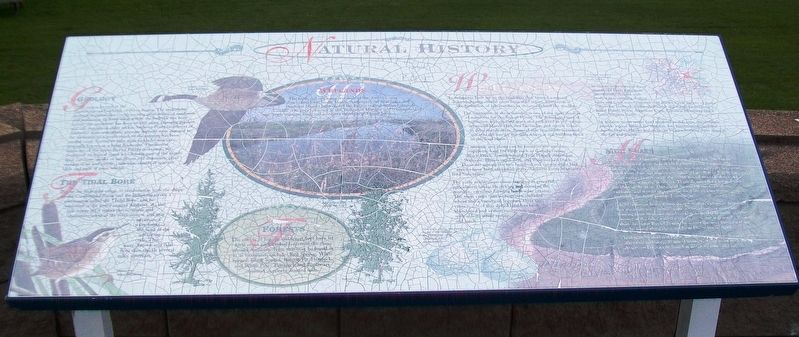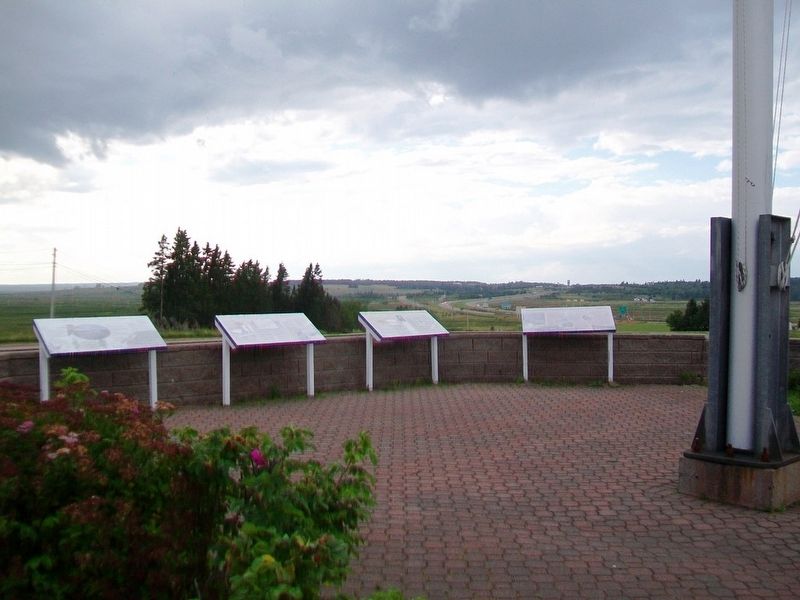Natural History
Geology
This area is located in the Carboniferous Lowlands of Nova Scotia. The underlying bedrock is sedimentary with varying proportions of sandstone and mudstone. In some areas where the bedrock has been folded, the sandstone has been eroded away, exposing gypsum and salt deposits in older rocks. Amherst Point (southeast of Amherst) is an area where gypsum deposits were exposed to the elements; as a result much of the gypsum has eroded away, leaving an area with sinkholes and caves generally known as a karst landscape. The diverse landscape of the upper Bay of Fundy ecosystem, six distinctive ecological zones which form part of the Fundy Trail EcoTear speaks of amethysts and dinosaurs, great wooden ships and swirling tide rips, clouds of migrant birds and pods of great whales.
The Tidal Bore
Due to the high tidal range, in combination with the shape of the Cumberland Basin and the inflowing rivers, a phenomena called the “Tidal Bore” can be observed in the rivers around Amherst. As the tide comes in, it enters the narrower and shallowing areas of the river estuary and as it advances, a wave forms at the head of the advancing tide. This wave, known as a tidal bore then travels several miles upstream.
Forests
The effects of logging and forest fires have left little or no undisturbed
Wetlands
The fresh and salt water wetlands of the Amherst area (including John Lusby Marsh, Amherst Point Sanctuary, and Amherst Marsh) form one of the largest coastal wetland areas in Canada. The area is known as the Tantramar Marshes and is comprised of bogs, swamps, fresh and saltwater marshes, and small lakes.
As sediments built up on the mud flats they formed a natural dyke sheltering coastal areas from tidal action. The result is the formation of salt marshes in the area behind the mudflats.
The vegetation of these marshes is one of the main sources of nutrients for the Bay of Fundy. The dominant types of vegetation include cord grass and rockweek in the wetter areas and Marsh Hay, Sea Lavender, and Arrow Grass in drier marsh areas. Some of this vegetation is carried out into the bay by the tides where it is a building block in the food chain.
Mussels and clams can be found in the marshes, supplying food for birds such as Canada Geese, Black Duck, Green-winged Teal, Pintail, American Widgeon, Blue-winged Teal, and Ring-necked Duck. These are among the two hundred and twenty-eight bird species [that] have been identified at
the Amherst Point Migratory Bird Sanctuary.The early settlers saw these marshes as potential agricultural lands. By dyking and draining the marshes, excellent farming lands were created. The main crops that were grown included wheat and a variety of legumes. Over the years much of this dyked land has been abandoned and is now overgrown with alders, white spruce, and larch.
In recent years some of these abandoned fields have been intentionally flooded with fresh water, creating shallow lakes and fresh water marshes that attract a new variety of ducks (Shoveler, Gadwall, Redhead, Ruddy), and marsh birds (Long-billed Marsh Wren, American Coot, Common Moorhen, Black Tern, Virginia Rail).
In addition to the water fowl attracted to this [area?], the wetlands provide a wood habitat for raccoon, fox, beaver, mink, and the Arctic Shrew. Hawks and owls can be seen hunting these areas in the fall and winter.
Mud Flats
[Illegible – Traditionally ?] one of the inner most regions affected by the Fundy tides, the coastal areas near Amherst have a tidal [?] of 15m. These strong, high tides bring muddy [several words illegible] eroded from slate and mudstone regions of the Bay of Fundy. As the sea rushes in and meets the [ocean ?] bound rivers it slows and deposits the [?] it carried. These deposits have formed salt [?] in the area. These mudflats are home to
These sediment laden waters do not support extensive fisheries but are relatively productive due to [several words illegible] flowing from local salt marshes. Due to the shallowness and the mixing of the tides with the rivers, the water is generally warmer than the outer Bay of Fundy. In winter the area freezes and ice can be found along the coast from December to April.
Traditionally shad and clams are fished from these waters. Various other fish including, Winter Flounder, Atlantic Salmon, and American Eel, can be found at different times of year.
Topics. This historical marker is listed in these topic lists: Animals • Environment • Waterways & Vessels.
Location. 45° 51.173′ N, 64° 15.596′ W. Marker is near Fort Lawrence, Nova Scotia, in Cumberland County. Marker is 50 meters NNW of the Nova Scotia Welcome Centre. Touch for map. Marker is at or near this postal address: 90 Cumberland Loop, Fort Lawrence NS B4H 3Y5, Canada. Touch for directions.
Other nearby markers. At least 8 other markers are within 5 kilometers of this marker, measured as the crow flies. Early Inhabitants (here, next to this marker); Fort Lawrence and English Settlement (here, next to this marker); Amherst – Modern Period 1800s and 1900s (here, next to this marker); Beaubassin (within shouting distance of this marker); Un hommage à/A Tribute to Jacob (Jacques) Bourgeois (within shouting distance of this marker); Beaubassin 1672-1750 (within shouting distance of this marker); Trans Canada Highway (about 120 meters away, measured in a direct line in New Brunswick); Jonathan McCully (approx. 4.2 kilometers away). Touch for a list and map of all markers in Fort Lawrence.
More about this marker. The marker is heavily checkered from weathering and is difficult to read.
Also see . . .
1. Bay of Fundy Mud Flats. (Submitted on September 27, 2017, by William Fischer, Jr. of Scranton, Pennsylvania.)
2. A Tidal Pulse: Life along the Bay of Fundy. (Submitted on September 27, 2017, by William Fischer, Jr. of Scranton, Pennsylvania.)
3. Bay of Fundy: The Intertidal Zones. (Submitted on September 27, 2017, by William Fischer, Jr. of Scranton, Pennsylvania.)
Credits. This page was last revised on December 3, 2020. It was originally submitted on September 27, 2017, by William Fischer, Jr. of Scranton, Pennsylvania. This page has been viewed 171 times since then and 9 times this year. Photos: 1, 2. submitted on September 27, 2017, by William Fischer, Jr. of Scranton, Pennsylvania.

